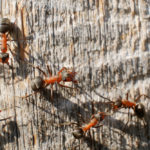
Termites Vs. Carpenter Ants: Behavior and Damage Types
In part one of this two-part blog series, we went over some basics on telling termites and carpenter ants, two somewhat similar insects and pest types, apart. While these may look and sometimes behave similarly, there are also enough differences that even an untrained homeowner can often tell them apart – which is important, because pest control and extermination themes may differ between them.
At Bug Busters, we’re here to help with numerous forms of insect control as part of our comprehensive residential and commercial pest control services, and properly identifying the insect in question is one of the steps we may take – though you, as a home or building owner, might be able to expedite the process by helping us in this area. While part one of our series went over the physical differences between these insects, today’s part two will dig into their differences in behavior and the kinds of damage they cause, plus why professional pest control assistance is often needed to deal with them.
Behavior Differences
When it comes to behavior, there are some notable differences between carpenter ants and termites. Termites are known to not only nest inside wood, but also to eat it as they create pathways; carpenter ants, on the other hand, only dig into the wood to create nests, but do not eat it and will instead push it out of openings in the galleries of their colonies.
For this reason, one simple identifier that may help you is the presence of small piles of wood shavings or frass (another term for insect waste) below the holes in your wood structures – if this is present, you can be fairly certain it’s carpenter ants, not termites, creating the problem.
Damage Types
Another major difference between these two is the actual type of damage you will see on your wood structures if you’ve identified their presence. Carpenter ant tunnels, for instance, will be smooth and well-finished; termite galleries, on the other hand, will be rougher and more ragged, as termites will also drag in layers of soil and mud between them.
In addition, if you see any mud tubes, termites are almost certainly the issue. Mud tubes are tubes found on the outside of walls, or sometimes between soil and wood, and allow termites to travel between pieces.
Professional Control Themes
If you’ve spotted any of the significant signs we just went over, it’s important to contact our team for professional pest control. These signs indicate that an infestation is already underway or fully taking place in your home or building, but our team will get to the bottom of the issue and its extent, removing these harmful insects before they create any further damage.
For more on how to tell termites and carpenter ants apart, or to lean about any of our insect control or other pest control services, speak to the staff at Bug Busters today.
